Ultimate Guide to Different Types of Shoe Construction
In this blog post we break down the different types of shoe constructions and their pros and cons.

In the world of footwear, beyond the allure of design and the pull of brand names, lies the intricate and essential realm of shoe construction.
At its core, the way a shoe is constructed determines not just its aesthetic appeal but its soul - its comfort, durability, and overall functionality. Just as the foundation of a building holds the weight and ensures its standing through the test of time, so does the construction of a shoe bear the weight of daily use and environmental challenges.
The method of construction is the unsung hero, often overlooked by the casual buyer, but deeply appreciated by connoisseurs.
When you dive into the differences of shoe construction, you quickly realize that the difference between a shoe that lasts a season and one that lasts a decade often boils down to how it's made.
The construction method chosen can dictate the shoe's flexibility, its ability to mold to one's foot, its resilience to water and wear, and ultimately, its overall lifespan.
In the end, it boils down to the use case of the shoes and the construction can help buyers on their journey.
In this blog post we break down the different types of shoe construction as well as the pros and cons of each one:
Cemented or Glued Construction
Among the many ways to construct footwear, the cemented or glued construction method stands out for its simplicity and widespread use, especially in the realm of affordable and fashion-forward footwear.
- The Process: In the cemented construction, the shoe's upper is attached directly to the sole using a strong adhesive, typically a specialized shoe cement. After shaping the upper to a last (a foot-shaped mold), the insole is temporarily attached. The outsole is then glued to the shaped upper. Once the adhesive dries and sets, the shoe is complete. It’s a straightforward method that eliminates the need for stitching the sole to the upper, making it a faster and more cost-effective production technique.
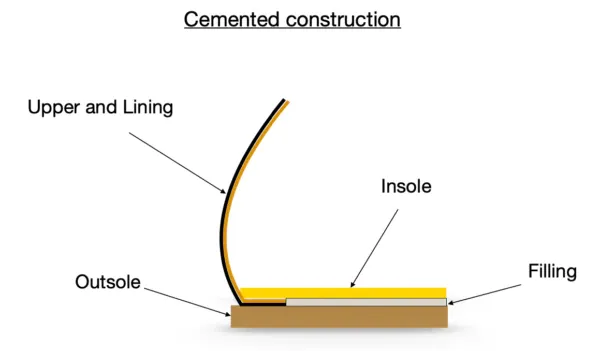
Pros:
- Cost-Effective: Given the simplicity of this construction method, it often results in a lower production cost, which can be passed on to the consumer. This is why many budget-friendly shoes use cemented construction.
- Lightweight: Without additional layers or stitching, shoes made with this method tend to be lighter, providing a breezier feel, especially favorable for certain fashion or casual shoes.
Cons:
- Durability Concerns: The main drawback of cemented construction is its longevity. Since there's no stitching reinforcing the bond between the upper and the sole, these shoes might not withstand years of heavy use as effectively as some other construction methods might.
- Repair Limitations: Over time, the adhesive bond can weaken, and once the sole is worn out or separated, it's often challenging to repair or replace it. This means that instead of having them repaired, many shoes with cemented construction are simply discarded once they've reached the end of their wear life.
Goodyear Welt Construction
The Goodyear Welt, a name often revered in the corridors of fine shoemaking, is synonymous with durability and craftsmanship. It's a construction method that traces its roots back to the 19th century and is named after its inventor, Charles Goodyear Jr. This technique is a hallmark of quality in footwear, ensuring that the shoe not only offers comfort but also stands the test of time.
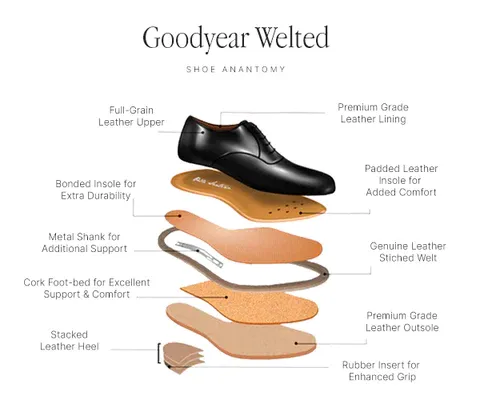
Description of the Goodyear Welt Process: The Goodyear welt construction involves stitching a leather, rubber, or plastic welt to both the upper and the insole, and then a separate stitch is used to attach the outsole. This creates a small cavity between the insole and the outsole, which is often filled with a flexible material, providing added comfort. The welt acts as a buffer between the insole and the outsole, allowing for repeated resoling as needed.
Pros:
- Durability: The dual stitching process, coupled with the use of a welt, adds significant durability to the shoes. They are built to endure, making them a favorite for those who prioritize longevity in their footwear.
- Easily Resoled: One of the standout features of Goodyear welted shoes is the ease with which they can be resoled. As the sole wears out, a skilled cobbler can replace it without disturbing the upper, giving the shoe a new lease on life.
- Water-Resistant: The construction technique creates a tight seal between the upper and the sole, ensuring a higher degree of water resistance, ideal for inclement weather conditions or environments.
Cons:
- Price Point: The meticulous process and the craftsmanship involved make Goodyear welted shoes generally more expensive than shoes made using other methods. However, many argue that the long-term value derived from such shoes justifies the initial investment.
- Weight: Due to the additional materials and layers used in the process, Goodyear welted shoes can be heavier than their counterparts, potentially making them less suitable for those seeking ultra-light footwear.
The Goodyear welt construction, with its storied history and undeniable benefits, remains a top choice for footwear enthusiasts. Though it comes with its set of drawbacks, its advocates will argue that the pros far outweigh the cons, especially when longevity and quality are the benchmarks of choice.
Blake Stitch Construction
A more streamlined counterpart to the Goodyear Welt is the Blake Stitch construction, a technique that offers a seamless blend of elegance and simplicity. While it shares some similarities with the Goodyear Welt, its distinct process and unique features make it a favored choice among certain shoe enthusiasts and manufacturers.
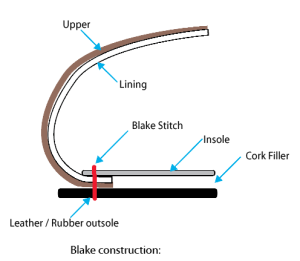
Explanation of How It Differs from Goodyear Welt: In Blake Stitch construction, the outer sole is directly stitched to the insole, bypassing the need for a welt. This method utilizes a single stitch that binds the outsole, insole, and upper together on the inside of the shoe. Because of this interior stitching, the sole is less prominent, and the shoe has a closer-cut profile. The absence of the welt makes the Blake Stitch method distinctively different from the Goodyear Welt, which uses a welt as an intermediary between the insole and outsole.
Pros:
- Flexibility: With fewer layers and no welt, Blake Stitched shoes tend to be more flexible right out of the box, offering a comfortable fit that adapts quickly to the foot's shape.
- Sleeker Profile: The absence of a welt and the closer-cut sole give these shoes a more refined, sleek appearance. This makes them particularly favored for dress shoes or more formal settings where a streamlined aesthetic is desired.
Cons:
- Water Resistance: Without the protective welt acting as a barrier, Blake Stitched shoes are generally less water-resistant compared to Goodyear Welted counterparts. Water can seep in through the stitches if exposed to wet conditions.
- Specialized Resoling: While resoling is possible, it requires specialized equipment to access the inner stitching. Not every cobbler is equipped to handle Blake Stitch resoling, which can make maintenance slightly more challenging.
Storm Welt Construction (Norwegian Welt)
Storm Welt (often interchangeably called the Norwegian Welt) stands out among other forms of construction for its utility and durability character. Stemming from regions with wet and unpredictable weather conditions, this construction technique is a testament to innovation meeting necessity.
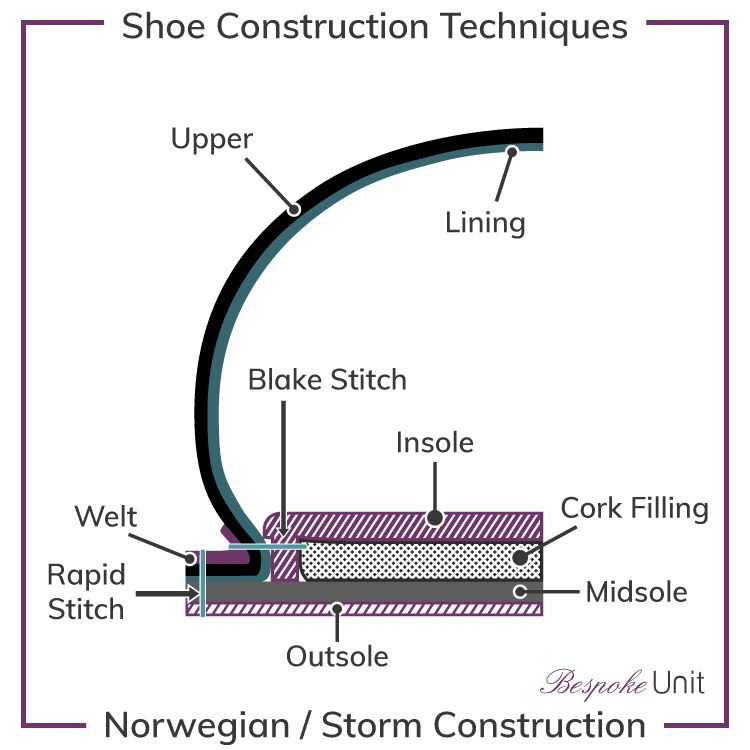
- Description of the Process:The Storm Welt construction is an adaptation of the Goodyear Welt, but with an added twist, or rather, a flange. This flange, which turns upwards, is stitched to both the upper and the insole. Subsequently, the outsole is attached separately. This unique construction creates a more pronounced welt with a special stitch, giving the shoe a distinct appearance and offering enhanced protection against water infiltration.
- Pros:
- Highly Water-Resistant: The main purpose of introducing the Storm Welt was to provide an added layer of protection against water. The turned-up flange acts as a barrier, making it difficult for water to seep into the shoe, thus keeping feet dry even in wet conditions.
- Rugged: Due to its design and the durability it promises, Storm Welt constructed shoes are perfect for outdoor adventures and unpredictable terrains. The robust build ensures longevity even with regular exposure to rough conditions.
Cons:
- Tends to Be Bulkier: The added layer of protection and the unique flange design give the shoe a bulkier profile compared to some of its counterparts, like the sleeker Blake stitch or Sacchetto constructions.
- More Expensive: The meticulous process of creating the storm welt, coupled with the materials used, often translates to a higher price point. However, many argue that the price is justified given the durability and protection the construction offers.
In the grand tapestry of shoe constructions, the Storm Welt carves its niche. While it might not be the go-to choice for a formal evening gala, those who prioritize function and resilience over form, especially in challenging weather conditions, will find a faithful companion in shoes constructed using this method.
Stitchdown Construction
Stitchdown construction stands out as a method that perfectly merges traditional craftsmanship with practical benefits. It's a unique process that might not be as renowned as its Goodyear or Blake Stitch peers, but for those in the know, it offers a series of advantages, especially for those who prize flexibility and repairability in their footwear.
Overview of Stitchdown Construction:The defining feature of the Stitchdown method is how the upper leather is prepared. Instead of tucking it inwards as in many other shoe construction methods, the upper is flanged outwards and then stitched directly to the midsole. This results in a visible "lip" or flange on the edges of the shoe, which not only gives it a distinctive aesthetic but also plays a functional role in how the shoe wears over time.
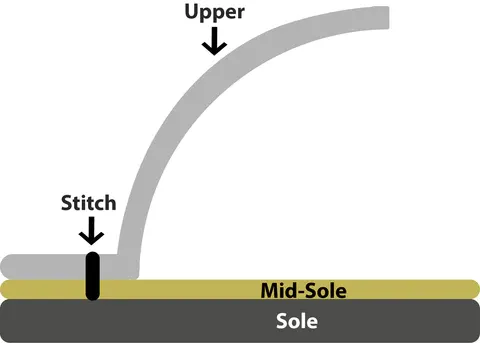
Pros:
- Flexibility: Owing to the reduced number of layers and the direct connection between the upper and the midsole, Stitchdown shoes offer exceptional flexibility, making them comfortable from the very first wear.
- Reparability: One of the standout features of Stitchdown construction is how amenable it is to repairs. The visible external stitching allows cobblers to easily resole or restitch the shoe, thereby prolonging its lifespan.
Cons:
- Water Resistance: While the flanged out upper and external stitching lend the shoe its unique appearance, it also makes it somewhat vulnerable to water infiltration. Stitchdown shoes generally offer less water resistance compared to methods like the Goodyear welt, which have additional barriers to prevent water from seeping in.
Stitchdown construction might not boast the widespread recognition of some other shoe construction techniques, but for those who value a combination of flexibility and the option for easy repairs, it presents a compelling choice. With its unmistakable look and feel, it's a method that beckons to those who have an eye for detail and an appreciation for tried-and-true craftsmanship.
Sacchetto Construction
Diving deeper into the intricacies of shoe construction, we find techniques like the Sacchetto construction. Rooted in Italian shoemaking traditions, the Sacchetto method, which translates to "little bag" in Italian, takes an almost inside-out approach to shoe crafting that emphasizes comfort above all.
Brief Explanation of Sacchetto Construction:At its core, the Sacchetto method forgoes the use of a traditional insole, instead opting for a very thin one. The shoe's lining and its upper are stitched together, forming a "pocket" of sorts, which is then filled with a special, supple material to enhance comfort. The shoe's sole is then directly attached, resulting in an exceptionally soft, glove-like fit that feels like a second skin around the foot.
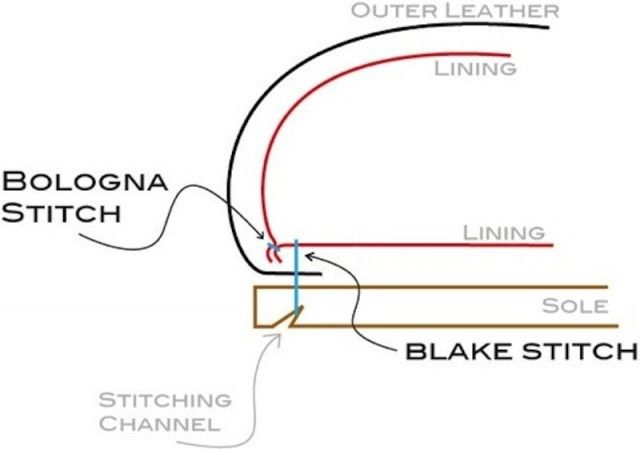
Pros:
- High Comfort: Sacchetto shoes are revered for their unmatched comfort. The absence of a stiff insole and the glove-like fit ensure the foot is cradled in a soft, adaptive environment, making long hours of wear a breeze.
- Flexibility: Given the fewer rigid components and the shoe's innate softness, Sacchetto-constructed shoes showcase a high degree of flexibility, adapting quickly to the foot's unique movements and contours.
Cons:
- Durability: The very factors that make the Sacchetto method comfortable and flexible also result in a trade-off when it comes to durability. Lacking the structural reinforcement of welted methods, Sacchetto shoes might not stand up to the same levels of wear and tear over extended periods.
Sacchetto construction is the epitome of luxury shoemaking, where comfort is paramount. While it may not be the go-to choice for those seeking a shoe for rigorous, everyday use, it's perfect for those occasions when unparalleled comfort and elegance are the top priority.
Moccasin Construction
When tracing back the roots of shoe-making craftsmanship, one cannot overlook the storied tradition of the Moccasin construction. Deeply embedded in the practices of indigenous North American tribes, Moccasin shoes have journeyed from ancient origins to modern wardrobes, striking a harmonious balance between simplicity and comfort.
Discussing Its Origins: Moccasins originated from the native tribes of North America, where they were crafted primarily from soft, pliable leather, often from deerskin or similar materials. These shoes were designed for their functionality in both warm and cold climates. The construction involved crafting a shoe from a single piece of leather, wrapping around the foot and stitched on top. This ensured a snug fit, providing both warmth and a feel of the ground below, connecting the wearer to the earth.
Modern Use: Today, while the essential design remains true to its origins, moccasins have been incorporated into various styles, from loafers to driving shoes. Modern moccasins might use different materials or incorporate supportive insoles, but the basic construction technique remains, offering that signature comfort and casual look.
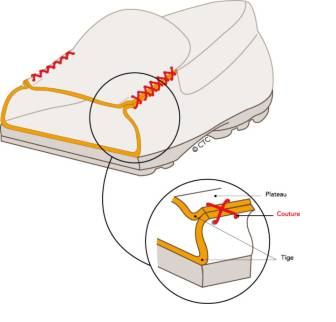
Pros:
- Comfortable for Casual Wear: Moccasin construction provides a flexible and adaptable fit, contouring to the wearer's foot shape over time. This makes them exceptionally comfortable for long periods of wear, particularly for casual settings.
Cons:
- Not Suitable for Dress Shoes: The casual, relaxed appearance of the moccasin construction doesn't lend itself to the structured, polished look that dress shoes typically require. As such, while you might find moccasin-style loafers, they are rarely considered appropriate for formal events.
Moccasin construction stands as a testament to time-honored traditions and the power of simplicity. While they may not be the first choice for a black-tie event, for those seeking a shoe that offers a harmonious blend of comfort and casual elegance, moccasins are hard to beat.
Comparison and Personal Preference
When we stride into the world of footwear, we're not just looking for a shoe. We're seeking an experience, one tailored to our needs, activities, and aesthetic inclinations.
Matching Construction to the Occasion:
- Formal Events: For a polished, sophisticated appearance, shoes with structured constructions like the Goodyear Welt reign supreme. The sturdy build and clean finishing lines make it apt for a formal setting, be it an important business meeting or a black-tie event. Blake stitich
- Daily Wear: On an average day, comfort is key. Here, more flexible methods like Sacchetto come into play. Its glove-like fit and adaptability make it perfect for prolonged periods of wear, especially when one desires both comfort and a touch of elegance.
- Rough Usage: For those who are hard on their shoes, or often tread on uneven terrains, durability becomes important. Storm Welt construction offers an advantage, being able to withstand significant wear and tear and offering the possibility of resoling.
The Power of Personal Preference: At the crossroads of functionality and style, personal preference emerges as a determining factor. For some, the allure of the Goodyear Welt, with its history and the promise of longevity, is irresistible. On the other hand, those who value the sensation of wearing a shoe that molds seamlessly to the foot might gravitate towards the soft embrace of the Sacchetto method.
Furthermore, while technical aspects matter, the emotional resonance a shoe offers can't be overlooked. Maybe it's the artisanal aura of a Goodyear-welted shoe, echoing tales of old-world craftsmanship, or the plush, luxurious feel of a Sacchetto-crafted slipper evoking Italian finesse.
In the end, it all boils down to what speaks to you. Are you looking for a lifetime companion in footwear, sturdy and reliable? Or are you seeking that ephemeral sensation of walking on air, even if just for a few cherished moments? Your shoes, your story. Make your choice count.
Conclusion
In the vast world of footwear, where choices are aplenty and styles ever-evolving, the construction of a shoe remains its silent backbone. It's the unsung hero, the foundation upon which the aesthetics and functionality rest. And just like any structure, the strength and durability of a shoe hinge upon the quality of its foundation.
Understanding shoe construction isn't just about appreciating the craftsmanship that goes into every pair; it's about making informed decisions. Every shoe has a story to tell, a purpose to serve, and when we delve deeper into its construction, we align our needs with the shoe's potential. Whether you're looking for the rugged reliability of a Storm Welt for those adventurous treks, the refined sophistication of a Goodyear Welt for formal settings, or the snug comfort of a Sacchetto construction for everyday wear, recognizing the intricacies of each method allows for a tailored shoe experience.
Investing in quality shoe constructions isn't just a matter of spending more; it's about valuing longevity and sustainability. Quality constructions often mean longer-lasting footwear, leading to fewer replacements and, consequently, less waste. It's an investment not just in the now, but in the future.
As you stride ahead, let your steps be confident, knowing that beneath your feet lies craftsmanship honed over centuries, tailored to serve your journey. Because, in the end, it's not just about the shoe—it's about the miles they’ll carry you.

